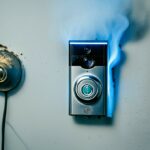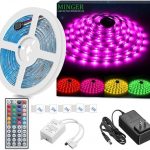Last Updated on 3 months by Francis
When it comes to doorbell systems, safety should always be a top priority. You may be wondering, can doorbell wires shock you? In this article, we will explore the potential hazards of doorbell wires and provide safety precautions to prevent electrical shocks.
Most doorbell systems consist of three main components: pushbuttons, wiring, and a transformer. The wiring in doorbell systems carries low-voltage current, usually less than 16 volts. This low voltage makes doorbell wires generally safe to handle. However, it is essential to exercise caution and follow safety guidelines when working with live wiring.
Contents
Key Takeaways:
- Doorbell wires carry low-voltage current and are generally safe to handle.
- Follow safety precautions when working with live wiring to avoid electrical shocks.
- Regular maintenance and inspections of the doorbell system are crucial for safety.
- If in doubt or for complex tasks, seek professional assistance from an electrician or doorbell specialist.
- By following safety guidelines and taking necessary precautions, you can enjoy the convenience of a functioning doorbell system without unnecessary risks.
How Do Doorbell Systems Work?
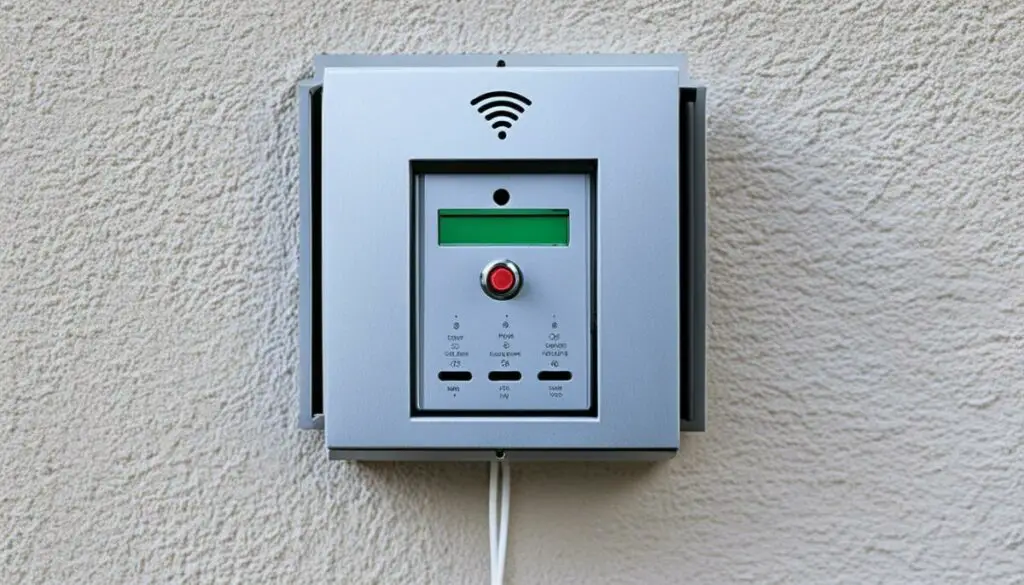
Doorbell systems play a crucial role in alerting homeowners to visitors at their doorsteps. Understanding how these systems work can help users troubleshoot issues and make informed decisions when installing or replacing doorbell components. Let’s take a closer look at the key elements that make up a doorbell system and the process by which they function.
The Components of a Doorbell System
A typical doorbell system comprises three main components:
- Pushbuttons: These are the surface-mounted buttons located on the exterior of a property. When pressed, they initiate the signal that activates the doorbell inside the house.
- Wiring: The wiring serves as the conduit for the electrical current, ensuring a continuous flow between the pushbuttons, transformer, and doorbell.
- Transformer: The transformer is responsible for converting the high-voltage current from the household electrical supply (usually 120 volts) into a low-voltage current (typically less than 16 volts) suitable for powering the doorbell system.
The pushbuttons, wiring, and transformer work together to form a complete electrical circuit within the doorbell system.
The Functioning of a Doorbell System
When a visitor presses the pushbutton, it completes the circuit, allowing the low-voltage current to flow through the wiring. This current is then carried to the transformer, which steps down the voltage to a safe level. The transformed low-voltage current continues along the wiring to the doorbell, activating the bell or chime inside the house. The sound alerts the occupants that someone is at the door.
It’s important to note that doorbell systems operate on low-voltage current, significantly reducing the risk of electrical shocks. However, it’s still essential to exercise caution when handling live wiring or performing any maintenance or repairs on the system.
“A doorbell system functions by completing an electrical circuit, with the pushbutton initiating the signal, the transformer reducing the voltage, and the wiring connecting all the components. Understanding this process can help troubleshoot issues and ensure the system works properly.”
By understanding the basic principles of how doorbell systems work, homeowners can be better equipped to maintain, troubleshoot, or upgrade their systems as needed. In the next section, we will explore the potential hazards posed by doorbell wires and the safety precautions to be taken.
Are Doorbell Wires Dangerous?
In general, doorbell wires are not dangerous due to their low-voltage current. However, it is important to be aware of potential electrical hazards and safety risks associated with doorbell wires. While the low-voltage current in doorbell systems is generally safe, certain situations can pose a safety concern.
If the transformer fails or if there is a fault in the wiring, it can result in dangerous levels of current flowing through the wires. This situation is rare, but it has the potential to cause an electrical shock. It is crucial to take precautions and handle doorbell components and wiring with care to minimize these risks.
Preventing Electrical Hazards
To ensure safety when working with doorbell wires, it is important to follow these guidelines:
- Always turn off the power to the doorbell system before working on the wiring.
- Use insulated tools to prevent electrical shocks.
- Avoid contact with water or other sources of moisture while working on the wiring.
By adhering to these precautions, you can minimize the potential risks associated with doorbell wires and ensure a safe working environment. It is always better to exercise caution and take preventive measures when dealing with electrical components.
Remember, even though doorbell wires typically carry low-voltage current, neglecting safety measures can lead to unexpected hazards. Always prioritize your safety and follow the necessary precautions.
Identifying and Addressing Faulty Wiring
If you suspect a fault in your doorbell wiring, it is important to address it promptly to prevent any potential risks. Here are some signs that may indicate faulty wiring:
- Flickering or dimming lights when the doorbell is pressed
- An intermittent or non-functioning doorbell
- Sparks or unusual sounds coming from the doorbell system
If you notice any of these signs, it is recommended to seek professional assistance. An experienced electrician can diagnose and repair any faulty wiring, ensuring the safety of your doorbell system and minimizing the risk of electrical hazards.
Safety Precautions for Working with Doorbell Wires
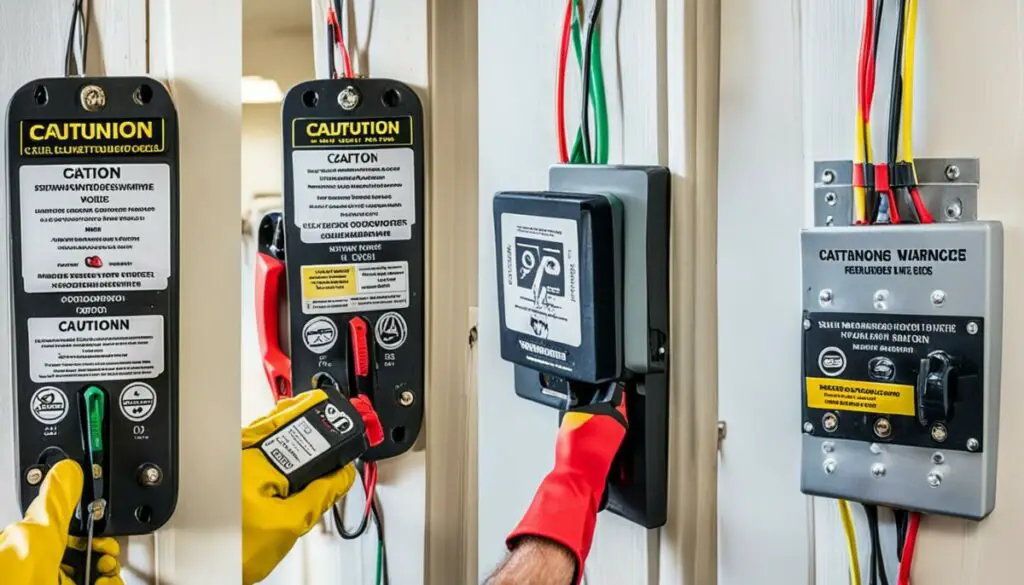
When working with doorbell wires and handling doorbell components, it is essential to prioritize safety and take necessary precautions to prevent any potential harm. Here are some guidelines that should be followed:
- Testing current strength: Prior to touching the wiring, always test the strength of the current to ensure it is within a safe range. This can be done using a neon test lamp or a multimeter.
- Avoiding live components: If you have a pacemaker or any other medical device that may be affected by electric currents, it is important to avoid handling live doorbell components or wiring.
- Turning off power: Before attempting any repairs or installations, ensure that the power to the doorbell system is turned off. This precautionary measure minimizes the risk of electrical shock.
- Using insulated tools: When working with the wiring, use insulated tools to prevent electrical shocks. Insulated tools provide an added layer of safety by reducing the chances of accidental contact with live circuits.
- Avoiding moisture: It is crucial to avoid contact with water or other sources of moisture when working on the wiring. Moisture can conduct electricity and increase the risk of electric shock.
By adhering to these safety precautions, individuals can significantly reduce the potential hazards associated with working with doorbell wires. Prioritizing safety is essential to ensure a safe and efficient process while handling doorbell components and wiring.
| Safety Precautions | Benefits |
|---|---|
| Testing current strength | Ensures safe handling of wiring |
| Avoiding live components | Prevents potential interference with medical devices |
| Turning off power | Reduces the risk of electrical shock |
| Using insulated tools | Provides protection against electrical shocks |
| Avoiding moisture | Minimizes the risk of electric shock |
Diagnosing Doorbell Malfunctions
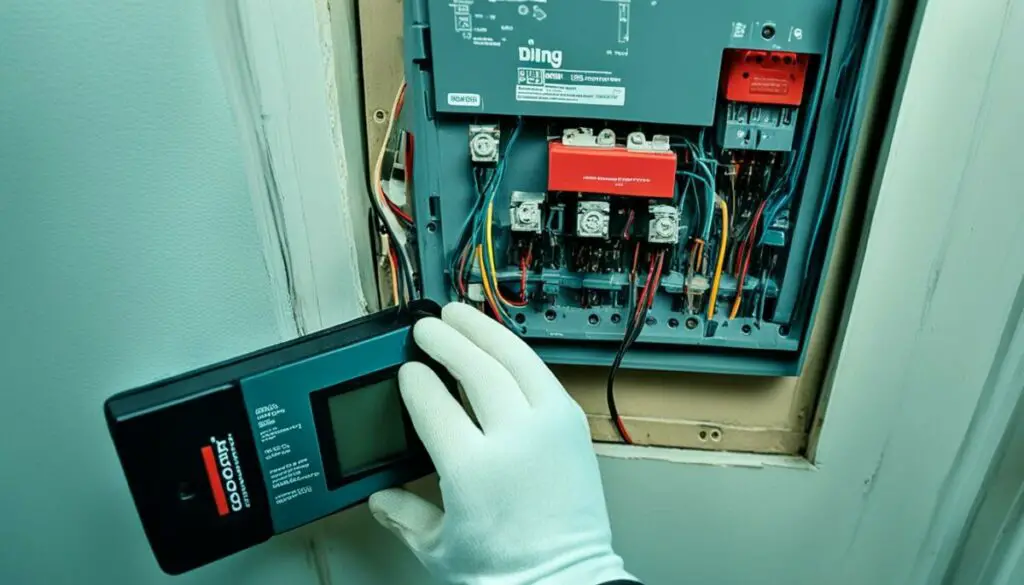
When your doorbell starts acting up, it can be frustrating and inconvenient. Thankfully, diagnosing the issue doesn’t have to be complicated. In most cases, doorbell malfunctions are due to faulty pushbuttons or wiring problems. By following a few simple steps, you can troubleshoot and identify the cause of the problem, getting your doorbell back in working order.
- Step 1: Remove the Button
- Step 2: Test the Current
- Step 3: Assess the Results
- Step 4: Faulty Pushbutton
Start by carefully removing the pushbutton from the wall. Be cautious not to touch any wires during this process.
Next, use a neon test lamp or a multimeter to test the strength of the current on the terminals of the button. This will help determine if there is sufficient current flowing through the wires.
If the test lamp lights up, it could indicate that there is too much current flowing to the terminals. This may indicate a faulty transformer, which can be a potential hazard and should be addressed by a professional.
If only one button of a two-button system is not working, it is likely a faulty pushbutton that needs to be replaced. Consider replacing the button with a new one to restore functionality.
By following these steps, you can quickly diagnose common doorbell malfunctions and determine the appropriate course of action. If you’re unsure or uncomfortable working with electrical components, it’s always best to seek the assistance of a professional to ensure the safety and proper functioning of your doorbell system.
Expert Tip:
If you’re unsure about troubleshooting your doorbell or if the issue persists after attempting these steps, it’s best to consult with a professional electrician who specializes in doorbell systems. They have the expertise and knowledge to diagnose and resolve complex doorbell malfunctions.
Make sure to troubleshoot your doorbell
issues to restore functionality and convenience.
Installing a New Doorbell System
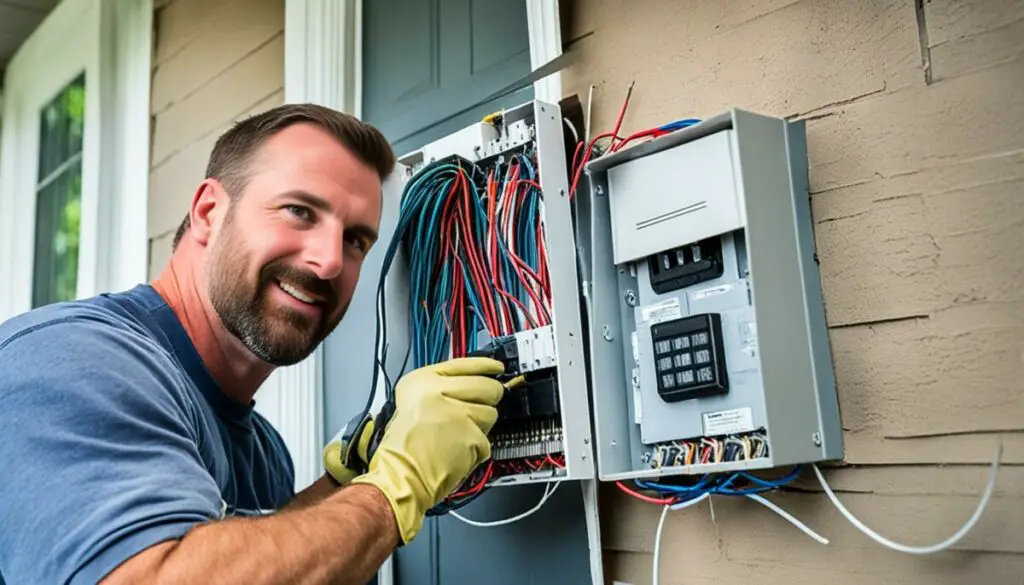
If your doorbell system is worn out or poses safety risks, it is recommended to replace it with a new one. Installing a new doorbell system is relatively straightforward and can be done by following these steps:
- Locate the main electrical box and turn off the breaker for the doorbell.
- Remove the old doorbell unit from the wall, disconnecting the wiring carefully.
- Install the new doorbell unit using the existing wiring, making sure to connect the wires correctly.
- Secure the new doorbell unit to the wall using screws.
- Turn on the breaker and test the new doorbell system to ensure it is functioning properly.
When replacing a doorbell system, it is important to follow safety guidelines to ensure a safe installation. Here are some safety precautions to keep in mind:
- Always turn off the power to the doorbell system before working on the wiring.
- Use insulated tools when handling the wiring to avoid electrical shocks.
- If you are unsure about the installation process, it is recommended to hire a professional electrician.
By following these steps and taking the necessary safety precautions, you can successfully install a new doorbell system and ensure the safety of your home.
Choosing Between Wired and Wireless Doorbells

When it comes to selecting a doorbell system for your home, you are faced with the choice between wired and wireless doorbells. Both options have their own unique advantages and disadvantages, so it’s essential to consider your specific needs and preferences before making a decision.
Wired Doorbells: Reliable Performance and Minimal Maintenance
Wired doorbells are known for their reliable performance and consistent connection to your home’s electrical system. These doorbells require professional installation as they rely on existing wiring within your home. Once installed, they offer stability and minimal maintenance, making them a popular choice among homeowners who value a reliable and durable doorbell system.
With wired doorbells, you don’t have to worry about batteries running out or wireless signal interference. They provide a direct power source, ensuring your doorbell is always functional and ready to alert you when someone is at the door.
Wireless Doorbells: Installation Flexibility
If you’re looking for more installation flexibility, wireless doorbells are worth considering. As the name suggests, these doorbells do not rely on existing wiring and are powered by batteries. This means you can install them anywhere within range, without the need for complex wiring installations.
Wireless doorbells are particularly suitable for renters or homeowners who want the freedom to change the placement of their doorbell or relocate it easily. They offer a hassle-free installation process and can be set up in a matter of minutes.
Pros and Cons Comparison
| Wired Doorbells | Wireless Doorbells |
|---|---|
| Reliable performance | Installation flexibility |
| Consistent connection to electrical system | No need for existing wiring |
| Minimal maintenance | Quick and easy installation |
| Require professional installation | Battery-powered, may require periodic replacement |
Choosing between wired and wireless doorbells ultimately depends on your personal preferences and the specific requirements of your home. If you prioritize reliable performance and a direct power source, wired doorbells are an excellent choice. However, if you value installation flexibility and the ease of relocation, wireless doorbells offer a convenient solution.
Consider the pros and cons of each option, weigh the importance of reliable performance versus installation flexibility, and make the decision that best suits your needs. Whether you go for the reliability of wired doorbells or the convenience of wireless doorbells, both options can provide an effective solution for greeting your guests and enhancing the security of your home.
The Importance of Regular Maintenance
Regular maintenance is crucial to ensure the proper functioning and safety of your doorbell system. By performing routine checks and preventative measures, you can identify and address any faults or potential issues before they escalate. Here are some maintenance tasks that you should prioritize:
- Check the Doorbell Buttons: Regularly inspect the doorbell buttons for any signs of wear or damage. If you notice any cracks, loose connections, or unresponsiveness, it may be necessary to replace them. Faulty buttons can affect the overall functionality of your doorbell system.
- Inspect the Wiring: Take the time to examine the wiring of your doorbell system. Look for frayed or exposed wires, as they can pose a safety risk. If you discover any issues, it is essential to address them promptly by repairing or replacing the wiring.
- Test the Current Strength: Periodically test the strength of the current flowing through your doorbell wiring. This can be done using a suitable testing device or a multimeter. Ensuring that the current falls within the safe range is vital for both the functionality and safety of your system.
- Clean the Bell or Chime Unit: Over time, debris and dust can accumulate on the bell or chime unit of your doorbell system, affecting its performance. Regularly clean these components to maintain their effectiveness and prevent any obstructions.
By adhering to these regular maintenance tasks, you can promote the longevity and reliability of your doorbell system. Prevention and early detection are key in avoiding potential faults and maintaining a safe environment for you and your family.
Hiring a Professional for Doorbell Repairs and Installations
While it is possible to handle some doorbell repairs and installations on your own, it is advisable to hire a professional for more complex tasks. Electricians and doorbell specialists have the necessary expertise and knowledge to handle the electrical wiring safely. They can diagnose any issues with the doorbell system, perform necessary repairs or replacements, and ensure that the installation is done correctly. Hiring a professional not only ensures your safety but also guarantees a properly functioning doorbell system.
The Benefits of Professional Doorbell Services
Electricians and doorbell specialists offer a range of valuable services that contribute to safe doorbell repairs and installations:
- Expertise and Wiring Expertise: Professionals have a deep understanding of doorbell systems and electrical wiring principles. They can navigate complex wiring layouts, identify potential hazards, and implement safe solutions.
- Safe Installations: Professionals ensure that doorbell systems are installed correctly, following industry standards and safety guidelines. They have the tools and knowledge to handle the electrical components and secure wiring connections.
- Efficient Troubleshooting: If your doorbell system is malfunctioning, professionals can quickly diagnose the problem. They have the experience to pinpoint issues and provide efficient solutions, saving you time and frustration.
- Quality Repairs and Replacements: When parts of your doorbell system need repair or replacement, professionals can source high-quality components and perform the necessary work with precision. This ensures long-lasting functionality and reliability.
“Hiring a professional for your doorbell repairs and installations guarantees a safe and reliable solution, providing you with peace of mind.”
Whether you are dealing with a faulty doorbell, need a new installation, or want to upgrade your current system, enlisting the help of a professional can save you time, effort, and potential risks. Professional doorbell services offer reliable expertise and ensure that your doorbell system operates smoothly and safely.
Choosing the Right Electrician
When hiring a professional for your doorbell repairs and installations, consider the following factors:
- Experience and Credentials: Look for electricians or doorbell specialists with a proven track record in the industry. Check their qualifications, licenses, and certifications to ensure they have the necessary expertise.
- Reputation and Reviews: Read online reviews or ask for references from previous clients. A reputable professional will have positive feedback and testimonials from satisfied customers.
- Insurance Coverage: Verify that the electrician carries liability insurance to protect you in case of any accidental damages or injuries during the job.
- Transparent Pricing: Request a detailed quote that outlines the scope of work, materials, and labor costs. Make sure there are no hidden fees or surprises when it comes to the final bill.
- Communication and Professionalism: Choose an electrician who communicates clearly, listens to your needs, and is professional in their interactions. Good communication ensures that everyone is on the same page throughout the project.
By carefully selecting a qualified and reliable professional for your doorbell repairs and installations, you can enjoy the benefits of a safe and properly functioning doorbell system.
| Advantages of Hiring a Professional for Doorbell Repairs and Installations |
|---|
| Expertise and Wiring Expertise |
| Safe Installations |
| Efficient Troubleshooting |
| Quality Repairs and Replacements |
Conclusion
In conclusion, doorbell wires are generally safe due to their low-voltage current. However, it is essential to handle them with caution and follow safety precautions to prevent any potential electrical hazards. Regular maintenance and inspections of the doorbell system are necessary to ensure its proper functioning and safety.
If you encounter any doubts or need assistance with more complex tasks, it is highly recommended to seek the help of a professional electrician or doorbell specialist. These experts have the required knowledge and expertise to handle repairs and installations safely, minimizing any potential risks.
By taking these precautions and adhering to safety guidelines, you can enjoy the convenience of a fully functional doorbell system without compromising your safety or security.
FAQ
Can doorbell wires shock you?
Doorbell wires carry low-voltage current, usually less than 16 volts, making them safe to handle. However, caution should still be exercised when dealing with live wiring.
How do doorbell systems work?
Doorbell systems consist of pushbuttons, wiring, and a transformer. When the pushbutton is pressed, it completes the electrical circuit, allowing the current to flow through the wiring and activate the bell or chime inside the house.
Are doorbell wires dangerous?
In general, doorbell wires are not dangerous due to their low-voltage current. However, if the transformer fails or there is a fault in the wiring, it can lead to dangerous levels of current and potentially result in an electrical shock.
What are the safety precautions for working with doorbell wires?
When working with doorbell wires, it is important to test the strength of the current, turn off the power, use insulated tools, and avoid contact with water or moisture.
How can I diagnose doorbell malfunctions?
To diagnose doorbell malfunctions, you can remove the button and test the current strength using a neon test lamp or a multimeter. This can help identify issues such as a faulty transformer or pushbutton.
How do I install a new doorbell system?
To install a new doorbell system, you need to locate the main electrical box, turn off the breaker, remove the old unit, connect the new unit using the existing wiring, and secure it to the wall.
Should I choose a wired or wireless doorbell?
Wired doorbells offer reliable performance and connect to your home’s electrical system, while wireless doorbells provide more flexibility in terms of installation. Consider your specific needs and preferences when choosing between the two.
How important is regular maintenance for doorbell systems?
Regular maintenance is important to ensure proper functioning and safety of the doorbell system. Tasks include checking for wear or damage, inspecting wiring, testing current strength, and cleaning the bell or chime unit.
Should I hire a professional for doorbell repairs and installations?
Hiring a professional electrician or doorbell specialist is advisable for more complex tasks. They have the expertise to handle the electrical wiring safely, diagnose issues, perform repairs or replacements, and ensure correct installations.
Is it necessary to take safety precautions with doorbell wires?
Yes, it is necessary to take safety precautions with doorbell wires to avoid any potential electrical hazards. By following safety guidelines and handling the wiring with caution, you can minimize any risks.




